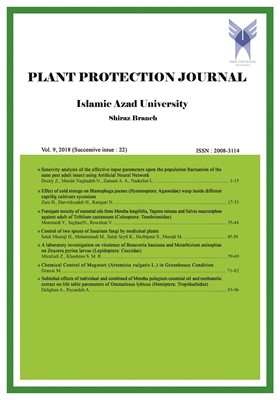A laboratory investigation on virulence of Beauveria bassiana and Metarhizium anisopliae on Zeuzera pyrina larvae
Subject Areas : Plant ProtectionZahra Mirafzali 1 , Sayed Mohammad Reza Khoshroo 2
1 - Department of Biology (Microbiology), Islamic Azad University, Science and Research, Sirjan
2 - Department of Biology, Islamic Azad University, Kerman
Keywords:
Abstract :
Zeuzera pyrina (Linnaeus, 1761) (Lepidoptera: Coccidae) is a polyphagous pest that feeds more than 100 plant species. Entomophagous fungi are one of the limiting factors to control the population of this pest in nature. In this study, the lethal effect of two fungi Metarhizium anisopliae and Beauveria bassiana on the first and second larval instars of Zeuzera pyrina was investigated in laboratory conditions. The first and second instar larvae of Z. pyrinia were collected from the branches of walnut trees in Baft, Kerman province, Iran. The larvae were transferred to sterile Petri dishes after sterilization with Mercury chloride and distilled water. Spore suspension at concentrations of 1.5 ×10 6, 1.5×10 7, 1.5×10 8 conidia/ml was prepared, and then mortality rate of adults was examined after 5, 6, 9, 12, 14, 16 days. The lowest value LC50 in presence of B. bassiana (16 day), M. anisoplaie (12day) and two combined fungi (50:50), M. anisoplaie and B. bassiana (9 day) was 1/5×104.5, 1/5×103.9 and 1/5×102.2 conidia/ml respectively. Therefore, the combination of two B. bassiana and M. anisoplaie fungi had the best effect in the shortest time and M. anisoplaie had better effect than B. bassiana. Nowadays, biological control is one of the best and most practical control programs to protect of environment; biological control of pests, chemical pesticides that have harmful effects on humans and other organisms. In this study, the simultaneous use of two fungi B. bassiana and M. anisoplaie caused to 100% mortality of woodworker worm larvae during 16 days in concentration of1/5 ×10 8 conidia/ml.
_||_


